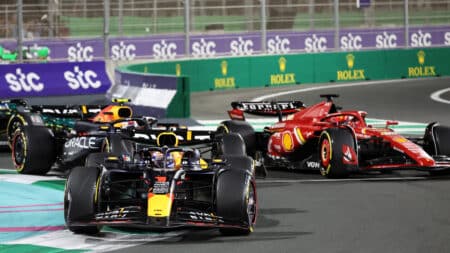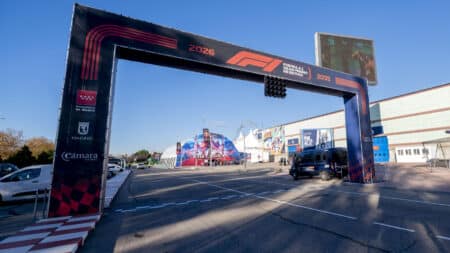
Which Red Bull will show up in Jeddah? - What to watch for at Saudi GP
Can Red Bull rebound from its poor Bahrain showing? And will it be Piastri or Norris leading McLaren's charge? Here's the five themes to watch for at the Saudi Arabian GP
Jean-Pierre Beltoise, having harried the victorious Lotus 72D of Emerson Fittipaldi in the closing stages of April 1972’s International Trophy at Silverstone, climbed wistfully from his BRM P160: had he had two good arms, he mused, he would have won that one.

He was alluding to the accident at the 1964 Reims 12 Hours that had almost killed him. The coma was temporary, but the burns and damage to his left arm were permanent. So awkward was his subsequent driving style – swivelling that locked limb from its shoulder – that Tony Southgate, designer of the BRM P160 Beltoise would race in 1972, had to cut a hole in the monocoque to accommodate it.
The little Parisian, though, was resilient and adaptable, as successful motorbike racers tend to be. A year-minus-a-day since the crash, he scored Matra’s maiden Formula 3 victory, in a whirling slipstreamer – at Reims. The following year, 1966, he beat Chris Irwin’s Brabham to win the prestigious Monaco F3 race. He was pretty tasty for ‘damaged goods’.
Jackie Stewart scored BRM’s fourth consecutive Monaco Grand Prix victory that year too; it would have been its fifth had not Graham Hill suffered a late engine failure in 1962.

Plenty had changed since then: this most British of teams had by 1972 sold its skin, if not quite its soul, to American corporate consumerism in the form of Marlboro’s carcinogenic cowboy, while Monte Carlo’s besmirching of its baroque opulence with high-rise, low-rent (yet expensive) blocks of buildings had gone into overdrive: the 19th century railway station that had given motor racing’s most famous hairpin its name had long gone, swiftly followed by the viaduct that had so splendidly framed the turn-in to Portier. Now, the grand plan was to push back the sea.
This was the penultimate year of the track’s transition: the arched tunnel, with its decorative masonry and low-level, in-case-of-emergency lighting, had yet to be bulldozed; the bijou bar-tabac let into some grand stone public stairs was still skimmed by the cars before they curved along the harbourfront to the no-nonsense doubling-back of the Gasometer Hairpin. All as Tazio Nuvolari had known it.
There were short-term changes, however: the pits had been relocated to the seafront before Tabac and was accessed via the old Chicane, while a new Chicane, tighter, narrower and with a much faster approach (along what is today’s escape road), was sited so that only a short chute separated it from Tabac.

The pit area was still cramped, of course. There being five BRMs of three different types didn’t help. Howden Ganley, in the team’s new but understeery and unloved P180, sometimes had to remind the overworked Southgate of their most recent set-up change: “You’d come into the pits during practice and there would always be two or three BRMs there. You just had to wait your turn. It was frustrating.”
Beltoise, Ganley and Peter Gethin were scrabbling for superiority in an ‘A’ team not yet recovered from the deaths in 1971 of Pedro Rodriguez and Jo Siffert, while Helmut Marko and Reine Wisell were having to make do with ‘B’ status. ‘Jenks’ called it “motley”.
Ha, but the circuit suited BRM’s torquey, patched-up V12s: Beltoise qualified fourth, Gethin sixth. Indeed, there were five ‘12s’ in the top six – two Ferraris, plus the aforesaid BRMs and a Matra – and only Fittipaldi’s Lotus upheld Cosworth DFV honour in second place. It might have been different had not the final practice session been affected by rain. That, however, was an indicator of conditions to come.
Puddles became rivers became torrents that spilled into the sea. Beltoise ordered his rear anti-roll bar to be removed, and BRM’s chief mechanic, Alan Challis, worked a neat trick on the grid with the fuel injection pump’s drive belt, retarding the engine to make it more tractable.
Beltoise enjoyed such conditions because they reduced the steering load on his compromised arm; BRM preferred them because its engine bearings ran cooler. This was their Perfect Storm.
Ste Dévote’s throat had been choked by a new Armco goitre, but Beltoise went for the jugular even so, hanging grimly to his longer ratios to slither between Jacky Ickx’s Ferrari and the inside barrier to emerge, with a flick of a fish’s tail, in the lead. Do or die. Pour la gloire! For the next 20 laps he continued to court disaster – Jenks noted a “touch of desperation” to it – but it paid rich dividends. Even Ickx, a genuine wet-weather great, floundered in the inspired Frenchman’s wake.
A rhythm eventually fell upon Beltoise, who, though leading, was having to pick off backmarkers-in-the-mist with bewildering frequency; he even gave Tim Schenken’s Surtees the hip-and-shoulder on the run down to Lower Mirabeau: “It was the only way to overtake.”
After 2h 27m of unstinting effort and occasional blind faith – albeit at an average of 64mph – 35-year-old Beltoise, a driver who might have been great rather simply extremely good but for his physical circumstances, had completed his day of days. Ickx, smoother but slower, was 38.2s in arrears. Fittipaldi, third, had been lapped once. Stewart, struggling to fourth in a Tyrrell with a worsening misfire, had been lapped twice, and Brian Redman (McLaren) and Chris Amon (Matra), the other points finishers, thrice.
Time had stood still in Formula 1 for perhaps the last time. Straw bales had lined sections of the circuit; craning photographers had stood with one foot on the pavement, their others on the track; the Tunnel had echoed down the years; and BRM, old school despite its funky new duds, had scored what would prove to be its final GP win.
Within three weeks the Belgian GP had been held at anodyne Nivelles instead of Spa and Bernie Ecclestone had realised that there would be distinctly more money to be made as a race promoter than as a team owner.
By 1973, Monaco, complicated further by its new mini-Mickey Mouse sections – Swimming Pool, La Rascasse and Anthony Noghès – was hemmed by Armco, and the F1, suddenly at arms’ length even here, that burst from its new ‘tunnel’ was aspirational rather than inspirational: a subtle but important shift.

Can Red Bull rebound from its poor Bahrain showing? And will it be Piastri or Norris leading McLaren's charge? Here's the five themes to watch for at the Saudi Arabian GP

McLaren's breakthrough in a near-four-year-old ruleset shows F1 rules convergence is a myth – just like Sebastian Vettel, Red Bull and Renault did in 2013, writes Mark Hughes

Madrid finally has a consortium to build the new Formula 1 circuit that will host the 2026 Spanish GP

Helmut Marko caused a stir after the Bahrain GP with his worries that Max Verstappen could leave Red Bull early. But how real are those fears?